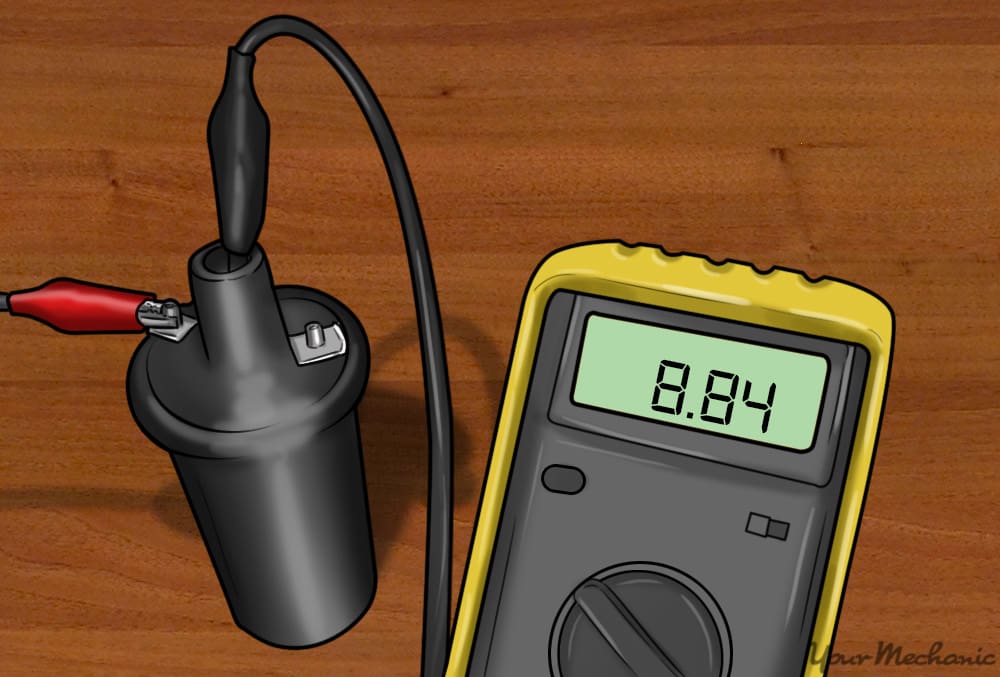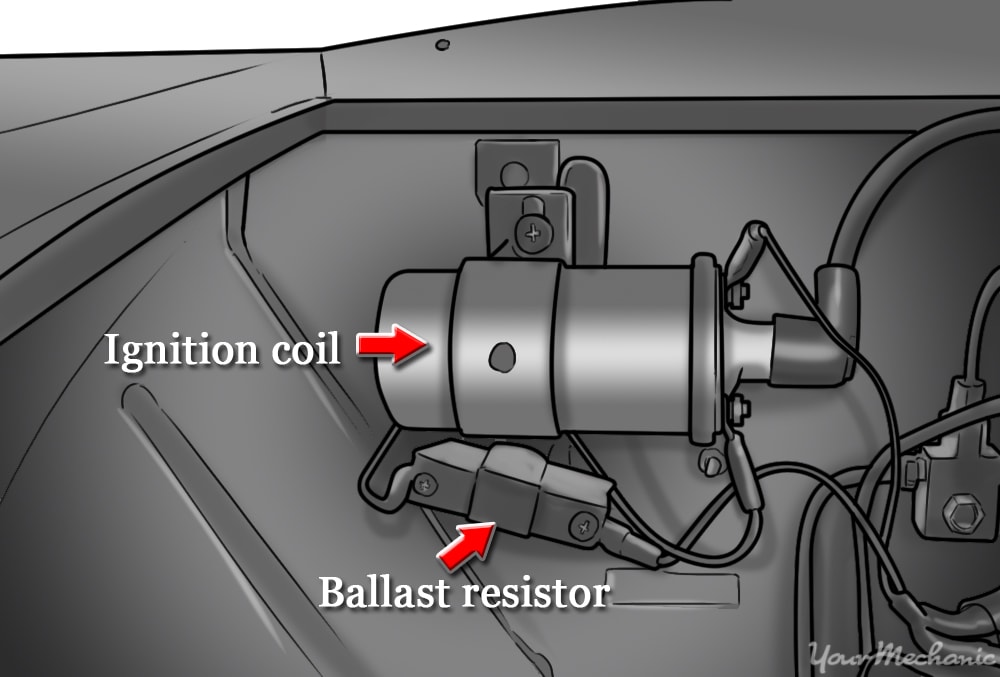Ballast resistor wiring refers to the use of a resistor to limit the current flow in a circuit, specifically in lighting applications. A ballast resistor is connected in series with a load, such as a fluorescent light, to regulate the voltage and current supplied to the load.
The main purpose of ballast resistor wiring is to ensure that the load receives the appropriate amount of power and voltage to operate efficiently. It prevents excessive current from flowing through the load, which could damage the component or cause premature failure. Ballast resistors are commonly used in fluorescent lighting systems to limit the current to the fluorescent tube, allowing it to operate at its optimal brightness and extending its lifespan.
Ballast resistor wiring has played a crucial role in the development of lighting technology. The early fluorescent lights used high-voltage starters to initiate the discharge process, but these starters were prone to failure. Ballast resistors provided a more reliable and efficient solution by regulating the current flow, eliminating the need for starters and reducing maintenance costs. Today, ballast resistor wiring remains an essential component in many lighting systems, contributing to their reliability and longevity.
Ballast resistor wiring is a crucial aspect of lighting systems, influencing the performance, efficiency, and lifespan of the lighting components. Understanding the essential aspects of ballast resistor wiring is vital for electrical engineers, lighting designers, and anyone involved in the installation and maintenance of lighting systems.
- Function: Ballast resistor wiring regulates the current flow in a circuit, specifically in lighting applications, preventing excessive current from flowing through the load (such as a fluorescent light) and ensuring optimal operation.
- Components: Ballast resistor wiring typically includes a resistor connected in series with the load, limiting the current and regulating the voltage supplied to the load.
- Applications: Ballast resistor wiring is commonly used in fluorescent lighting systems, high-intensity discharge (HID) lighting systems, and other lighting applications where current regulation is necessary.
- Benefits: Ballast resistor wiring extends the lifespan of lighting components, reduces maintenance costs, and improves the overall efficiency and reliability of lighting systems.
- Safety: Ballast resistor wiring plays a crucial role in ensuring the safety of lighting systems by preventing electrical hazards such as overheating and short circuits.
- Design Considerations: The selection and design of ballast resistors involve factors such as the load’s voltage and current requirements, as well as the desired operating conditions.
- Historical Development: Ballast resistor wiring has evolved over time, with the introduction of electronic ballasts and other advancements leading to improved efficiency and performance.
- Industry Standards: Ballast resistor wiring must comply with industry standards and regulations to ensure safety and reliability.
- Environmental Impact: Ballast resistor wiring can contribute to energy efficiency and reduced environmental impact by optimizing the performance of lighting systems.
These essential aspects of ballast resistor wiring highlight its importance in various dimensions, from function and components to applications, benefits, and safety considerations. Understanding these aspects is crucial for effective design, installation, and maintenance of lighting systems.
Function
Within the broader scope of ballast resistor wiring, its function plays a pivotal role in ensuring the efficient and reliable operation of lighting systems. Ballast resistor wiring regulates the current flow in a circuit, preventing excessive current from damaging sensitive lighting components and ensuring optimal performance.
- Current Regulation: Ballast resistors limit the current flow to a specific level, preventing excessive current from reaching the load. This is particularly important for fluorescent lights, which require a specific amount of current to initiate and maintain a stable discharge.
- Voltage Regulation: By controlling the current flow, ballast resistors also regulate the voltage supplied to the load. This ensures that the load receives the appropriate voltage for efficient operation, preventing damage from over-voltage or under-voltage conditions.
- Load Protection: Ballast resistors protect the load from electrical hazards such as short circuits and overloads. By limiting the current flow, ballast resistors prevent excessive heat buildup and potential damage to the load.
- System Stability: Ballast resistors contribute to the stability of lighting systems by preventing voltage fluctuations and ensuring a consistent light output. This is especially important in applications where stable lighting conditions are crucial, such as in industrial settings or medical facilities.
In summary, the function of ballast resistor wiring in regulating current flow is essential for the proper operation and longevity of lighting systems. By preventing excessive current, regulating voltage, protecting the load, and contributing to system stability, ballast resistors ensure the reliable and efficient performance of lighting applications.
Components
Within the context of ballast resistor wiring, the components used play a crucial role in achieving the desired functionality and performance. The primary component of ballast resistor wiring is a resistor connected in series with the load. This resistor limits the current flow and regulates the voltage supplied to the load, ensuring optimal operation. Here are some specific aspects of the components used in ballast resistor wiring:
- Resistor Type: The type of resistor used in ballast resistor wiring depends on the specific application and load requirements. Common types include fixed resistors, variable resistors, and power resistors. Fixed resistors provide a constant resistance, while variable resistors allow for adjustable resistance values. Power resistors are designed to handle higher power dissipation.
- Resistance Value: The resistance value of the ballast resistor is critical in determining the current flow and voltage regulation. The appropriate resistance value is calculated based on the load’s voltage and current requirements.
- Power Rating: The power rating of the ballast resistor indicates its ability to dissipate heat without overheating. The power rating must be sufficient to handle the power dissipated in the resistor due to current flow.
- Mounting: Ballast resistors are typically mounted on a heat sink to dissipate heat effectively. Heat sinks help prevent the resistor from overheating and failing prematurely.
These components, when combined and configured appropriately, form the essential building blocks of ballast resistor wiring. Understanding the function and characteristics of these components is crucial for designing, installing, and maintaining effective ballast resistor wiring systems.
Applications
Within the broader context of ballast resistor wiring, its applications play a significant role in diverse lighting systems. Ballast resistor wiring finds its primary use in regulating current flow and ensuring optimal performance in various lighting technologies, including fluorescent lighting and high-intensity discharge (HID) lighting.
- Fluorescent Lighting: Ballast resistor wiring is extensively used in fluorescent lighting systems to regulate the current flow to the fluorescent tube. This ensures stable operation, prevents flickering, and extends the lifespan of the fluorescent lamp.
- High-Intensity Discharge (HID) Lighting: HID lighting systems, such as metal halide and high-pressure sodium lamps, require ballast resistor wiring to limit the current during the ignition process. This prevents excessive inrush current and ensures proper lamp starting.
- Other Lighting Applications: Ballast resistor wiring is also employed in various other lighting applications where precise current regulation is essential. These include neon signs, cold cathode fluorescent lamps, and certain types of LED lighting systems.
- Automotive Lighting: Ballast resistor wiring is used in automotive lighting systems to regulate the current flow to headlamps and other lighting components. This helps maintain proper voltage levels and prevents damage to the lighting system.
In summary, ballast resistor wiring finds its applications in a wide range of lighting systems, playing a crucial role in regulating current flow and ensuring optimal performance. Its use extends beyond fluorescent and HID lighting, encompassing various other lighting technologies and applications where precise current regulation is necessary.
Benefits
Ballast resistor wiring plays a pivotal role in enhancing the performance and longevity of lighting systems, leading to direct benefits in terms of lifespan, maintenance, efficiency, and reliability:
- Extended Lifespan: By regulating current flow, ballast resistor wiring prevents excessive current from damaging sensitive lighting components, such as fluorescent tubes and HID lamps. This extends the lifespan of the lighting components, reducing the frequency of replacements and associated costs.
- Reduced Maintenance Costs: The extended lifespan of lighting components directly translates to reduced maintenance costs. Fewer replacements and repairs lead to lower labor and material expenses, resulting in significant savings over the life of the lighting system.
- Improved Efficiency: Ballast resistor wiring optimizes the current flow to the load, ensuring efficient operation of the lighting components. This reduces energy consumption and lowers operating costs, contributing to a more environmentally friendly and cost-effective lighting system.
- Enhanced Reliability: Ballast resistor wiring stabilizes the electrical current, preventing voltage fluctuations and other electrical hazards. This enhances the overall reliability of the lighting system, minimizing the risk of failures and disruptions.
Real-life examples further illustrate the benefits of ballast resistor wiring:
- In fluorescent lighting systems, ballast resistor wiring is crucial for regulating the current to the fluorescent tube. This ensures stable operation, prevents flickering, and extends the lifespan of the fluorescent lamp, reducing maintenance costs and improving overall system reliability.
- In HID lighting systems, ballast resistor wiring is essential during the ignition process. It limits the inrush current, preventing damage to the lamp and ensuring proper starting. This contributes to the extended lifespan and reliability of HID lighting systems.
Understanding the connection between ballast resistor wiring and its benefits is essential for designing, installing, and maintaining effective lighting systems. By optimizing current flow and regulating voltage, ballast resistor wiring ensures optimal performance, extended lifespan, reduced maintenance costs, and enhanced reliability, ultimately contributing to efficient and cost-effective lighting solutions.
Safety
Ballast resistor wiring is a crucial component of lighting systems, responsible for regulating current flow and maintaining stable operation. Its inherent connection to safety stems from its ability to prevent electrical hazards, ensuring the well-being of users and the integrity of the lighting system.
Overheating and short circuits are common electrical hazards that can occur in lighting systems due to excessive current flow. Ballast resistor wiring acts as a safeguard against these hazards by limiting the current to a safe level. By doing so, it prevents excessive heat buildup and reduces the risk of electrical fires.
In fluorescent lighting systems, for example, ballast resistor wiring is essential for preventing overheating and short circuits. Fluorescent tubes require a specific amount of current to operate properly. Excessive current can cause the tube to overheat, leading to premature failure or even explosion. Ballast resistor wiring ensures that the current flowing through the tube remains within safe limits, extending its lifespan and preventing potential hazards.
Understanding the connection between ballast resistor wiring and safety is paramount. By regulating current flow, ballast resistor wiring plays a critical role in preventing electrical hazards, ensuring safe and reliable operation of lighting systems. This understanding guides the design, installation, and maintenance of lighting systems, ensuring adherence to safety standards and minimizing the risk of electrical accidents.
Design Considerations
Within the realm of ballast resistor wiring, design considerations play a pivotal role in ensuring the optimal performance and longevity of lighting systems. The selection and design of ballast resistors involve carefully considering various factors, including the load’s voltage and current requirements, as well as the desired operating conditions. Understanding these design considerations is crucial for engineers, technicians, and anyone involved in the installation and maintenance of lighting systems.
- Load Characteristics: The voltage and current requirements of the load are critical factors in ballast resistor design. The resistor must be able to limit the current flow to a level that is appropriate for the load, preventing damage or premature failure.
- Operating Conditions: The desired operating conditions, such as ambient temperature and operating hours, must also be taken into account. These factors can affect the power dissipation and heat generation of the resistor, necessitating appropriate selection and sizing.
- Ballast Type: The type of ballast used in the lighting system, whether magnetic or electronic, influences the design of the ballast resistor. Different ballast types have specific requirements for resistor characteristics, such as inductance and capacitance.
- Safety and Regulations: Ballast resistor design must adhere to safety standards and regulations to ensure the safe operation of lighting systems. This includes meeting requirements for insulation, voltage ratings, and fire resistance.
By carefully considering these design factors, engineers and technicians can select and design ballast resistors that optimize the performance and lifespan of lighting systems. Proper design ensures that the load receives the appropriate current and voltage, operates within safe parameters, and meets the desired operating conditions. This attention to design considerations ultimately contributes to efficient, reliable, and long-lasting lighting solutions.
Historical Development
The historical development of ballast resistor wiring has been instrumental in shaping the evolution of lighting systems. The introduction of electronic ballasts, along with other advancements, has played a critical role in improving the efficiency and performance of ballast resistor wiring.
In traditional lighting systems, magnetic ballasts were commonly used with ballast resistor wiring. However, electronic ballasts emerged as a more efficient and compact alternative. Electronic ballasts utilize solid-state components, such as transistors and integrated circuits, to regulate current flow more precisely. This advancement resulted in reduced energy losses, improved light output, and extended lamp life.
Another significant advancement in ballast resistor wiring is the development of dimmable ballasts. These ballasts allow for adjustable light intensity, providing greater control over lighting conditions. Dimmable ballasts incorporate sophisticated circuitry to vary the current flow to the load, enabling smooth dimming without compromising stability or performance.
The evolution of ballast resistor wiring has also led to the development of energy-efficient lighting systems. By optimizing the current flow and reducing energy consumption, ballast resistor wiring contributes to greener and more sustainable lighting solutions. This is particularly important in commercial and industrial settings, where energy efficiency is a key concern.
In summary, the historical development of ballast resistor wiring, marked by the introduction of electronic ballasts and other advancements, has been a driving force in enhancing the efficiency, performance, and versatility of lighting systems. These advancements have resulted in improved light output, extended lamp life, reduced energy consumption, and greater control over lighting conditions.
Industry Standards
In the context of ballast resistor wiring, adhering to industry standards and regulations is paramount for ensuring the safety and reliability of lighting systems. These standards provide a framework for the design, installation, and maintenance of ballast resistor wiring, ensuring compliance with safety requirements and optimal performance expectations.
-
National Electrical Code (NEC):
The NEC sets forth comprehensive electrical safety requirements in the United States, including those pertaining to ballast resistor wiring. Compliance with NEC guidelines ensures that ballast resistor wiring meets minimum safety standards for installation and operation. -
Underwriters Laboratories (UL) Certification:
UL is an independent safety certification organization that evaluates and tests electrical components, including ballast resistors. UL certification indicates that a ballast resistor has met rigorous safety standards and is suitable for use in lighting systems. -
International Electrotechnical Commission (IEC) Standards:
The IEC publishes international standards for electrical equipment, including those related to ballast resistor wiring. IEC standards provide a global benchmark for safety and performance, ensuring that ballast resistor wiring meets international quality and safety requirements. -
Local Building Codes:
Local building codes may impose additional requirements on ballast resistor wiring, taking into account specific regional or municipal regulations. Compliance with local building codes is essential for obtaining building permits and ensuring that lighting systems meet local safety standards.
By adhering to these industry standards and regulations, ballast resistor wiring is designed, installed, and maintained to meet stringent safety requirements. This helps prevent electrical hazards, ensures the reliable operation of lighting systems, and protects users from potential risks.
Environmental Impact
Within the realm of ballast resistor wiring, environmental impact holds significant importance. Ballast resistor wiring plays a crucial role in enhancing energy efficiency and reducing the environmental footprint of lighting systems.
-
Reduced Energy Consumption:
Ballast resistor wiring optimizes the current flow in lighting systems, ensuring that lighting components operate efficiently. Reduced energy consumption directly translates to lower electricity bills and a diminished carbon footprint. -
Extended Lifespan of Lighting Components:
By regulating current flow, ballast resistor wiring prevents excessive current from damaging lighting components, such as fluorescent tubes and HID lamps. Extended lifespan reduces the frequency of replacements and the associated disposal of hazardous materials. -
Energy-Efficient Lighting Solutions:
Ballast resistor wiring is a key component in energy-efficient lighting systems, such as T5 fluorescent lighting and LED lighting. These systems consume significantly less energy compared to traditional lighting, contributing to reduced greenhouse gas emissions. -
Improved Lighting Quality:
Properly designed ballast resistor wiring ensures stable current flow, resulting in consistent light output and improved lighting quality. This reduces the need for excessive lighting, further contributing to energy savings.
In summary, ballast resistor wiring not only enhances the performance and lifespan of lighting systems but also contributes to a greener and more sustainable environment. By optimizing energy efficiency, extending the lifespan of lighting components, and promoting energy-efficient lighting solutions, ballast resistor wiring plays a significant role in reducing the environmental impact of lighting systems.








Related Posts








